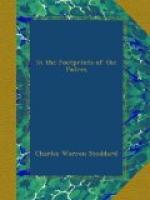Servants slip to and fro in sandals, offering edible birds’-nests, sharks’ fins, and beche de mer,—or are these unfamiliar dishes snatched from some other kingdom? At any rate, they are native to the strange people who have a little world of their own in our midst, and who could, if they chose, declare their independence to-morrow.
We see everywhere the component parts of a civilization separate and distinct from our own. They have their exits and their entrances; their religious life and burial; their imports, exports, diversions, tribunals, punishments. They are all under the surveillance of the six companies, the great six-headed supreme authority. They have laws within our laws that to us are sealed volumes. Why should they not? Fifty years ago there were scarcely a dozen Chinese in America. In 1851, inclusive, not more than 4,000 had arrived; but the next year brought 18,000, seized with the lust of gold. The incoming tide fluctuated, running as low as 4,000 and as high as 15,000 per annum. Since, 1868 we have received from 10,000 to 15,000 yearly.
After supper we leaned from the high balcony, among flowers and lanterns, and looked down upon the street below; it was midnight, yet the pavements were not deserted, and there arose to our ears a murmur as of a myriad humming bees shut in clustering hives; close about us were housed near twenty thousand souls; shops were open; discordant orchestras resounded from the theatres; in a dark passage we saw the flames playing upon the thresholds of infamy to expel the evil shades.
Away off in the Bay in the moonlight, glimmered the ribbed sail of a fishing junk, and the air was heavy with an indefinable odor which to this hour puzzles me; but it must be attributed either to sink or sandal-wood—perchance to both!
“It is a little bit of old China, this quarter of ours,” said the artist, rising to go. And so it is, saving only a noticeable lack of dwarfed trees and pale pagodas and sprays of willowy bamboo; of clumsy boats adrift on tideless streams; of toy-like tea gardens hanging among artificial rocks, and of troops of flat-faced but complaisant people posing grotesquely in ridiculous perspective.
[Illustration: The Farallones]
WITH THE EGG-PICKERS OF THE FARALLONES
Those who have visited the markets of San Francisco during the egg season may have noticed the abundance of large and singularly marked eggs, that are offered for sale by the bushel. The shells of these eggs are pear-shaped, parti-colored, and very thick. They range in color from a light green to grey or brown, and are all of them profusely spotted, or blotted, I might say spattered, with clots of black or brown. Some are beautiful, with soft tints blended in a delicate lace-like pattern. Some are very ugly, and look unclean. All are a trifle stale, with a meat of coarse texture and gamy flavor. But the Italians




